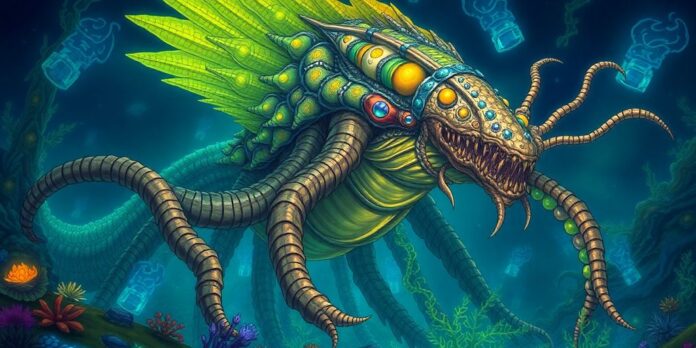A remarkable discovery has emerged from the depths of the Cambrian period, as scientists have identified a 506-million-year-old sea creature named Mosura fentoni. This bizarre organism, unearthed from Canada’s Burgess Shale, showcases an anatomy that resembles a creature straight out of a science fiction film, complete with three eyes and clawed limbs.
Key Takeaways
- Species Name: Mosura fentoni, named after the iconic kaiju Mothra.
- Age: Approximately 506 million years old, from the Cambrian period.
- Location: Fossils found in Canada’s Burgess Shale, known for exceptional preservation.
- Anatomy: Features include three eyes, clawed limbs, and a segmented tail with gills.
- Significance: Offers insights into early animal life and challenges previous assumptions about Cambrian predators.
The Discovery of Mosura Fentoni
The fossil of Mosura fentoni was meticulously studied and described in the journal Royal Society Open Science. This creature belonged to a group known as radiodonts, which includes other notable Cambrian predators like Anomalocaris. Unlike its larger relatives, Mosura was about the size of a human finger but possessed an equally strange appearance.
Unique Anatomical Features
Mosura fentoni is characterized by:
- Three Eyes: An unusual trait that raises questions about its vision and predatory behavior.
- Clawed Limbs: Adaptations that suggest a unique feeding strategy.
- Segmented Tail: Comprising 16 small sections lined with gills, this tail likely aided in respiration rather than propulsion, allowing it to thrive in low-oxygen environments.
Joe Moysiuk, the lead author of the study and curator at the Manitoba Museum, noted that the anatomy of Mosura challenges previous understandings of early arthropods. He emphasized the significance of the creature’s unique features, stating, "The ‘abdomen’ in Mosura is different in that its segments are small and they have only tiny flaps that would have been basically useless for propulsion."
Exceptional Fossil Preservation
The fossils of Mosura fentoni provide a rare glimpse into the internal anatomy of Cambrian organisms. Among the 61 specimens examined, researchers discovered:
- Preserved Nerve Tissues: Offering insights into the nervous system of early animals.
- Eye Structures: Indicating advanced visual capabilities for the time.
- Digestive Tract: Suggesting a complex feeding mechanism.
- Circulatory System: Some specimens displayed reflective patches interpreted as parts of an open circulatory system, akin to a heart pumping blood into body cavities.
This level of preservation is extraordinary and highlights the Burgess Shale’s unique conditions that allowed soft-bodied organisms to fossilize in such detail.
Cultural Connections and Future Implications
The discovery of Mosura fentoni not only enriches our understanding of ancient life but also illustrates the interplay between science and popular culture. Moysiuk pointed out that many science fiction creatures have been inspired by real organisms, and it is fitting that scientists draw inspiration from these fictional creations in return.
The striking morphology of Mosura, with its clawed limbs and gill-lined tail, evokes images of fantastical creatures from sci-fi franchises, blurring the lines between ancient reality and modern imagination. Moysiuk humorously suggested that future species names could be inspired by popular films, further intertwining the realms of paleontology and entertainment.
In conclusion, the discovery of Mosura fentoni not only adds a fascinating chapter to the story of early animal life but also serves as a reminder of the wonders of evolution and the creativity of nature, inspiring both scientists and sci-fi enthusiasts alike.


